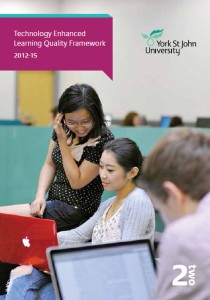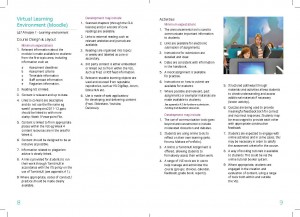
The primary aim of the YSJ TEL Quality Framework is to facilitate and encourage a consistent and well-considered approach to the use of Technology Enhanced Learning across the University.
The quality statements relate to firstly a set of minimum expectations, and secondly ideas that would further develop learning and teaching activities involving the use of Technology Enhanced Learning (TEL).
The statements are intended to establish a minimum standard in the use of a particular technology/tool and to ensure a consistent student experience. They are also intended to support tutors by providing examples of how to move beyond the minimum expectations towards the University’s vision of creating an exceptional student experience. The minimum expectation statements could be expressed as the lowest standard expected regardless of whether that particular technology is used to enhance, extend or empower students’ and their learning.
As the TEL team look to review the TEL Quality Framework, and with it the minimum expectations for VLE use, as part of my role as student researcher, I have been investigating sector-wide subscription to minimum standards and existing research into ePedagogy Models & Frameworks. The importance of benchmarking with other similar organisations is essential to identify trends in the sector and consider best practice, in particular to start with the existing research into the area. Step in Peter Reed, University of Liverpool, who has undertaken recent research around VLE minimum standards and identified that inconsistencies in the VLE have led to student dissatisfaction:
“The questionnaire results showed the vast majority of staff and students favour the introduction of minimum standards and identified specific items that should be included, for example handbooks, contact information for staff, access to previous modules, assessment information, further reading, etc.” (http://thereeddiaries.blogspot.co.uk/)
Indeed, Peter and his colleague Simon Watmough have expanded this further in their article Hygiene factors: Using VLE minimum standards to avoid student dissatisfaction, which explains how implementation of University minimum standards to the VLE can help to avoid student dissatisfaction. This research is further supported by findings in Students Expectations and Experiences of the Digital Environment. The study, commissioned by the Jisc co-design programme under the student innovation strand (August-October 2013), looked at what we know about students’ expectations and experiences of ICT at university. The study identified that the majority of students expect:
‘Consistent use of the VLE for course administration and course content.” (JISC, 2013)
Indeed many HEIs recognise the importance of delivering a good quality VLE experience to their students. We have identified many examples of good practice across the sector relating to VLE minimum standards, which can be broadly categorised into three groups.

Firstly, there are a number of simple checklists outlining minimum VLE content of which good examples include Herriot Watt University, VLE Minimum Criteria and Southampton Solent University, Minimum requirements for myCourse units. Each checklist outlines similar criteria: lecturer contact details, assessment information, timetable, learning materials, etc. Whilst all the arguably, essential information is included there is no encouragement for staff to further develop their VLE modules and include more interactive materials to enhance the students’ learning experience.
Secondly there are increasingly detailed checklists which incorporate minimum requirements but also encourage the use of more interactive media on the VLE. Exeter University has a code of good practice which includes a list of minimum requirements but in addition suggests recommended enhancements including external links, discussion forums and interactive group work, Exeter Learning Environment: Code of Good Practice. The University of Northampton suggests minimum standard for content, layout and format, however it expands upon these areas proposing staff also consider collaboration, communication and delivery, explaining that whilst not always appropriate for learning, social networking sites, eg Skype, Facebook may help with social cohesion and peer support. The provision of regular formative feedback is also a feature along with discussion boards and blogs to encourage collaboration, NILE Module Minimum Standards. There are also various examples of good practice regarding the accessibility of a VLE, for example the Bath Spa University has guidelines developed through an Accessibility Impact Assessment, Minerva. The UCL Moodle Baseline also highlights accessibility as part of its module recommendations, including minimum point size of text, consistent navigation between modules, contrasting backgrounds to text, etc. The UCL checklist is particularly helpful as it provides an example of a baseline Moodle course for staff to use as a template, yet it reassures staff that the baseline is advisory and not either prescriptive or restrictive, UCL Moodle Baseline.
Finally, there are more complex Rubric Standards that grade each of the different VLE quality criteria. Good examples are, Quality Matters Rubric, Quality Matters Rubric Standards 2011-2013 edition, and Blackboard Exemplary Course Program Rubric, Blackboard Exemplary Course Program Rubric. Each suggested category is afforded a weighting depending on level of accomplishment, consequently encouraging staff to improve the VLE offer to students by increasing engagement through interaction and collaboration. Items are weighted in terms of importance so those essential such as timetable can be given a higher rating than more optional items such as quizzes. These examples are quite complex however, rating the quality of VLE modules does offer opportunities to benchmark within faculties and across the wider HEI to ensure a minimum standard is being consistently applied.
The next stage in our project to develop new VLE minimum standards is to begin the consultation process with students and staff at YSJ. In the meantime if you have any questions or thoughts then please add your comments below!
Helen
5 responses on "VLE Standards, Thresholds, Expectations & Baselines"
Leave a Message
You must be logged in to post a comment.

A very interesting post Helen – I find the minimum requirements for the VLE very interesting. Although essential information is necessary, I wonder if there is a place for innovation here as well – hopefully so. I also find the minimum requirements for assignments interesting especially;
5. A mock assignment is available for practice …. and ….
7. Where possible and relevant, past assignments or exemplar materials are made available to students.
Would you consider that explanation of the marking criteria and how to achieve the learning outcomes would promote more independent and autonomous learning rather than providing past assignments? Could providing these lead to less a more ‘cookie cutter’ approach to the assignment?
Interested in your views on this and any research linking to it.
Hi Ian
I think you hit the nail on the head by pointing out that the minimum expectations are in place to ensure that essential information is present, leaving room for staff innovation when it comes to pedagogy.
The purpose of the 3E Framework (as well as other models & frameworks) is to then give staff ideas about how they might meaningfully incorporate some of the features of Moodle to enhance their delivery.
As you will see from the results of our students survey (in Fridays blog post), ‘Sample Exam Questions/Past Papers (Where Appropriate)’ did not feature in the top 10 of students responses, with only 44% of votes, so it is likely that this will not form part of any future minimum requirements, although may still be ‘desirable’ rather than ‘essential’.
‘Assessment Details/Requirements’ did feature very highly (78%) – so it’s obvious that students do value explanation of marking criteria etc. more highly.
Phil
Hi Ian
I forgot it was Good Friday tomorrow – the follow up blog post will go out this morning instead 🙂
Phil
This is a really interesting read, along with the student survey results. We’re currently in the process of putting together a ‘TEL Handbook’ with suggestions for minimum standards and it’s good to see that a lot of the things students cite as being useful are things we’re recommending. I suppose we’d be doing our jobs wrong if we weren’t!
Hi Rosie
Thanks for your comments! Interestingly, as we continue to revise our TEL Quality Framework, and add new elements to it etc., it is becoming more of a ‘TEL Handbook’ than just a single framework.
When it comes to the ‘minimum standards’ side of things, it is the student experience we are trying to have a positive impact on, so it is essential that we ask them what they want!
Phil